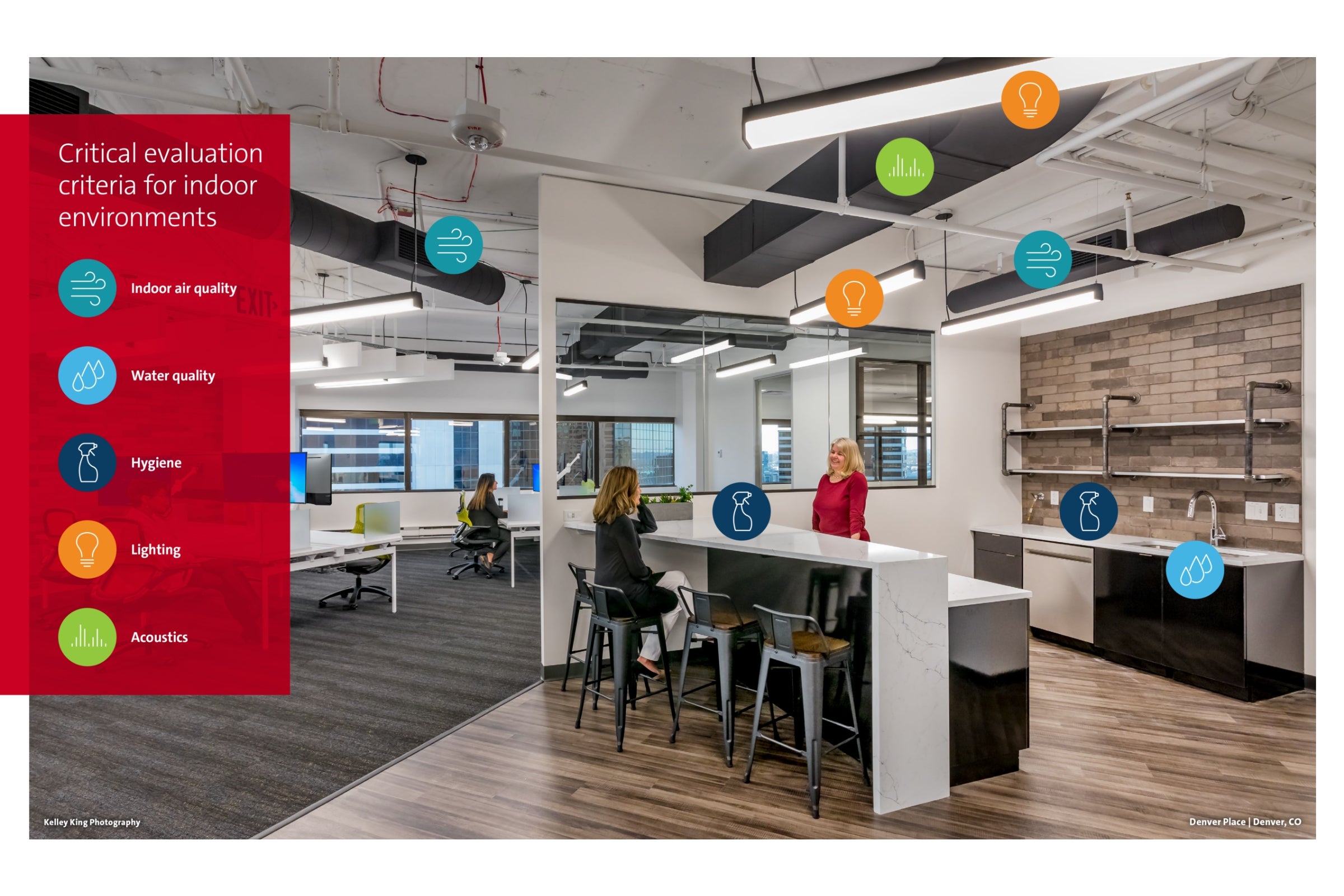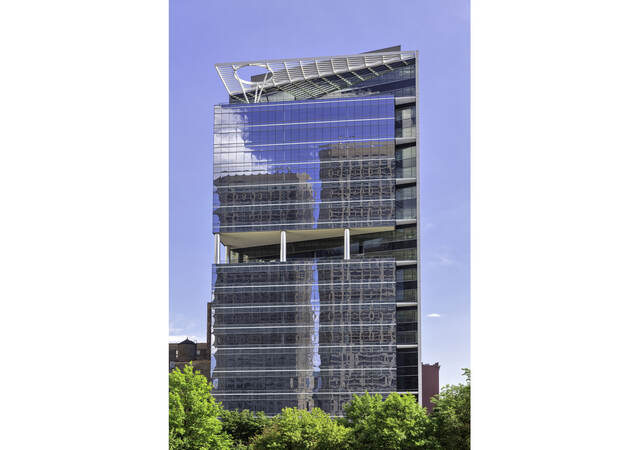
Provide science-driven verification for tenants and occupants
More than ever, property professionals need to demonstrate a commitment to indoor environmental health to secure and retain high-value tenants. Real estate leaders are taking strides to improve indoor environments, facilitate occupant comfort, health and wellness, secure more advantageous rental premiums and reduce tenant turnover.
The UL Verified Healthy Buildings program offers business leaders and real estate professionals and independent source of validation from a respected safety science leader. This program’s quantitative review process is driven by:
- 40 years of cumulative development.
- Building metrics discerned through performance testing.
- Comprehensive on-site visual inspections.
- Verification of policy implementation.
- *New - An environmental, health and safety (EHS) screening.
In a recent survey, MIT’s Real Estate Innovation Lab found that certified and registered “healthy buildings” command rents of 4-7.7% more per square foot than buildings without this distinction.
(Source: MIT Real Estate Innovation Lab. (2020). “The Financial Impact of Healthy Buildings.” https://realestateinnovationlab.mit.edu/research_article/the-financial-impact-of-healthy-buildings)
Watch the video
UL Verified Healthy Building
Look for the UL Verified Mark
UL Solutions has verified the indoor environmental quality of more than 280,674,151 square feet and 895 buildings to date.
Look for the UL Mark near you.

Addressing the indoor environment with a holistic, multifaceted approach
The Verified Healthy Building program features three tiers that examine different factors against accepted science-centric standards.
Verified Healthy Building for Indoor Air
This program option evaluates indoor air quality (IAQ), as well as policies and plans for the continual advancement of IAQ. UL Solutions teams inspect HVAC systems to verify that preventative maintenance is performed while focusing on ventilation, filtration and hygiene to help ensure continuous, excellent IAQ.
Verified Healthy Building for Indoor Air and Water
This program evaluates buildings for IAQ and water quality. This includes a detailed assessment to limit the risk of waterborne pathogens and testing for contaminants as outlined by the Environmental Protection Agency’s (EPA) drinking water standards to help ensure water is safe for consumption.
UL Solutions teams work with building stakeholders to develop a water management plan to help control Legionella and other bacteria in cooling towers and potable water systems.
Verified Healthy Building for Indoor Environment
This is the most holistic look at a building’s indoor environment, assessing IAQ and water quality as well as building cleanliness, lighting and acoustics. This selection also helps ensure that policies and plans have been developed and enacted to support the continual advancement of overall indoor environmental quality (IEQ).
The Verified Healthy Building Mark is aligned with science-centric standards from such third-party organizations as:
- American Society of Heating, Refrigerating and Air-Conditioning Engineers (ASHRAE)
- Centers for Disease Control (CDC)
- Environmental Protection Agency (EPA)
- Leadership in Energy and Environmental Design (LEEDv4.1)
- National Institute for Occupational Safety and Health (NIOSH)
- World Health Organization (WHO)
Helping ensure healthier indoor environments
Key performance assessment areas
The UL Solutions approach to assessing your built environment

Indoor air
Our program measures relevant air quality factors throughout the building. Specific measurements include the following factors that impact the health and safety of occupants:
- Temperature and humidity
- Carbon dioxide
- Volatile Organic Compounds (VOCs) and formaldehyde from building pollutants, such as cleaning products and off gassing from building materials, furnishings and personal effects
- Particulate levels
- Combustion gasses, carbon monoxide, nitrogen dioxide and sulfur dioxide related to cooking, vehicle exhaust and pollution
- Ozone, a pollutant related to smog
Additionally, a thorough qualitative inspection of the HVAC system focusing on ventilation, filtration and hygiene provides a predictive analysis helpful in maintaining good indoor air quality over time.

Water quality
This assessment focuses on overall optimal water quality:
- Develop a site-specific water management plan that includes guidance on Legionella risk reduction and procedures for maintaining a building’s water systems during times of low occupancy.
- Measure representative assets in the building’s potable water system to evaluate if the water meets the EPA’s primary standards for drinking water, including heavy metals and bacteria.
- Sample for Legionella in such high-risk assets as cooling towers and decorative fountains.

Hygiene
The cleanliness of a building is one of the most important visual aspects to tenants and occupants. Our team assesses the performance of your janitorial program to support occupant health and well-being, such as the cleaning of high-touch surfaces and overall building cleanliness.

Acoustics
This assessment measures background noise of the building’s fundamental mechanical systems to find excessive noise levels that may deter occupants’ ability to concentrate in working environments.

Lighting
This area focuses on lighting for safety and comfort:
- Analyze adequate lighting in common areas to facilitate safe egress.
- Identify fixtures with issues, such as flickering, that may affect visibility and impact comfort for occupants.

Benefits tailored to your built environment
Commercial and Corporate Real Estate

With the UL Verified Healthy Building program, owners and managers can show dedication to a work environment that prioritizes health, well-being and productivity. Feel confident that your building’s healthy environment can improve employee and occupant performance while increasing your building’s value and returns for stakeholders.
Hospitality
Employees and guests deserve a clear commitment to a healthy indoor environment. Our programs evaluate quality and cleanliness across various hospitality settings to provide your team with an optimal setting for rest and relaxation backed by third-party verification from UL Solutions.
Manufacturing
Specialized production environments feature industry-specific challenges regarding indoor environment management of factory floors or offices. Pollution control strategies are required to manage the needs of equipment, ingredients, components or chemicals.
Our program may help reduce risks in the manufacturing area and improve the environmental quality of adjacent office spaces, which can also lead to improved productivity.
Add to your existing green building achievements
The Verified Healthy Building program is designed to work in tandem with the requirements of other green building programs to support a building’s overall sustainability, health and wellness while not adding to an already intense regulatory workload. Download our brochure to learn more about how our programs overlap with certain markers for other third-party programs.
There are currently over 600 green building rating systems in use globally. The American Society of Heating, Refrigerating and Air-Conditioning Engineers (ASHRAE) released their annual certification and rating systems comparison, and ASHRAE recognized the UL Verified Healthy Building Mark as one of 17 rating systems with the most relevance to ASHRAE’s review criteria.
Contact us
Learn how to demonstrate your commitment to healthy indoor environmental quality with the UL Verified Healthy Building Mark. Let's get this conversation started.
Related products and services
- Environmental, Social, and Governance (ESG) Advisory and Assurance Services
- Energy Services for Healthy Buildings
- Green Building Services
- Enterprise Verification of Greenhouse Gas Statements to ISO 14064-3
- Indoor Environmental Quality Services for Healthy Buildings
- UL Verified Healthy Building Mark for New Construction
Case studies
- The Steady Pursuit of Healthier Indoor Spaces
- Cary, North Carolina is the First Fire Station to Earn UL’s Verified Healthy Building Mark
- Brookfield Properties Welcomes Back Tenants Safely
- Brandywine Prioritizes Indoor Environmental Quality in Cira Centre
- The Music Center Earns UL’s Verified Healthy Building Mark
- 1 Cal Reaches for Best in Class in Green Building
- Supporting a Healthier Indoor Environment with Policy and Performance









